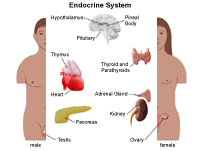Use Anatomical Terminology to Describe Endocrine Organs
The endocrine system is made up of organs called glands. Compare and contrast the endocrine system and the nervous system.

Anatomy Of The Endocrine System Johns Hopkins Medicine
Thyrnus spleen lymphatic vessels bones cartilages tendons.

. Tissue or organ that secretes hormones into the blood and lymph without ducts such that they may be transported to organs distant from the site of secretion. Pericardium Lun Diaphragm Stomach tines Greater omenturar Small intestines 2. Make sure you understand the differences between a neurotransmitter and a hormone.
Demonstrate the anatomical position and the anatomical planes and use directional terms to describe anatomical relationships. Describe differences between short-term and long-term stressresponses. Knowing these terms will make it much easier for us to understand the content of the following learning units.
Name the organ system to which each of the following sets of organs or body structures belongs. Terms are defined in reference to a theoretical person who is standing in what is called anatomical position see figure below. Explain interrelationships among molecular cellular tissue and organ functions in each system.
Human anatomy is the study of the structure of the human bodyAnatomical terms allow health care professionals to accurately communicate to others which part of the body may be affected by disorder or a disease. A gland is an organ that creates and releases substances that the body needs to function. B The ventral cavity.
Both feet pointing forwards. Endocrine System Homeostasis and Integration of Systems. Describe using anatomical termsdirections the location and special featurescolors of.
Describe using anatomical termsdirections the location and special featurescolors of the respiratory organs. Lymphatic Skeletal Endocrine 1. Experts are tested by Chegg as specialists in their subject area.
Before we get into the following learning units which will provide more detailed discussion of topics on different human body systems it is necessary to learn some useful terms for describing body structure. Located toward the back of the body is divided into the cranial cavity which holds the brain and vertebral or spinal cavity which holds the spinal cord. Anatomists and health care providers use terminology that can be bewildering to the uninitiated.
Glands produce and release different hormones that target specific things in the body. We review their content and use your feedback to keep the quality high. Terms in this set 55 Discuss the way in which hormones promote body homeostasis.
Thyroid gland pancreas thymus and adrenal gland. Assume that the pain is referred to the surface of the body above the organ. Endocrine glands which release hormones directly into the bloodstream.
Some glands are tiny about the size of a grain of rice or a pea. Often these cells are clustered together forming endocrine glands. Body cavities hollow spaces within the human body that contain internal organs.
Use appropriate anatomical terminology to identify key body structures body regions and directions in the body. Describe serous membrane and explain its function. You will be able to describe the bodys regions using the terms from the figure.
Unlike exocrine glands which have a duct for conveying secretions to the outside of the body eg sweat gland endocrine glands secrete substances directly into the surrounding interstitial fluid. Describe how endocrine function regulates growth and list thehormones involved in the process. Explain contributions of organs and systems to the maintenance of.
Certain directional anatomical terms appear throughout this and any other anatomy textbook Figure 113. These terms are essential for describing the. Hormones promote homeostasis by regulating activities such as sleep body temperature hunger and stress management.
However the purpose of this language is. Label each of the organs at the end of the supplied leader lines. Use anatomical terminology to identify and describe locations of major organs of each system covered.
Who are the experts. Describe using anatomical termsdirections the locations and special featurescolors of endocrine organs. Which body cavity would be opened to perform a hysterectomy.
You will be able to describe the bodys regions using the terms from the figure. Identify the anatomical regions of the body the body cavities and their organ systems. Use anatomical terms to describe the location of the adrenal glandsand the layers of the adrenal glands.
Located toward the front of the body is. 1710 Organs with Secondary Endocrine Functions. Hormones are released by secretory cells that are derived from epithelial tissue.
Examine both the anatomical and chemical systemic regulation of physiological processes Distinguish the roles of multiple systems in the maintenance of homeostasis Describe the interrelationships that exist among. A The dorsal cavity. Cells tissues and organs that secrete hormones as a primary or secondary function and play an integral role in normal bodily processes.
Use anatomical terminology to describe the location of the persons pain. You have glands all over your body including in your neck brain and reproductive organs. Describe the interdependency and interactions of the systems.
Pancreas pituitary adrenal glands. Anatomy What are the parts of the endocrine system. 1711 Development and Aging of the Endocrine System.
Identify skin fascia muscles. Use anatomical terminology to identify and describe locations of major organs of each system covered. There are two types of glands.
Interpret physiological processes for select body systems. Epiglottis glottis larynx trachea primary bronchus diaphragm and lungs. Distinguish between the posterior dorsal and the anterior ventral body cavities identifying their subdivisions and representative organs found in each.
The Endocrine System Hormones Medical Terminology For Cancer

An Overview Of The Endocrine System Anatomy And Physiology Ii

No comments for "Use Anatomical Terminology to Describe Endocrine Organs"
Post a Comment